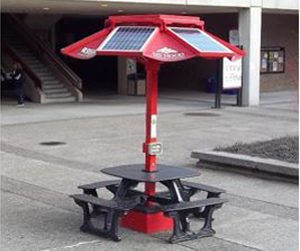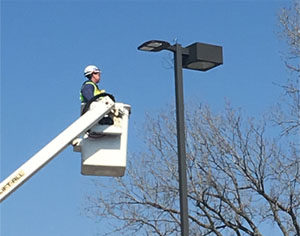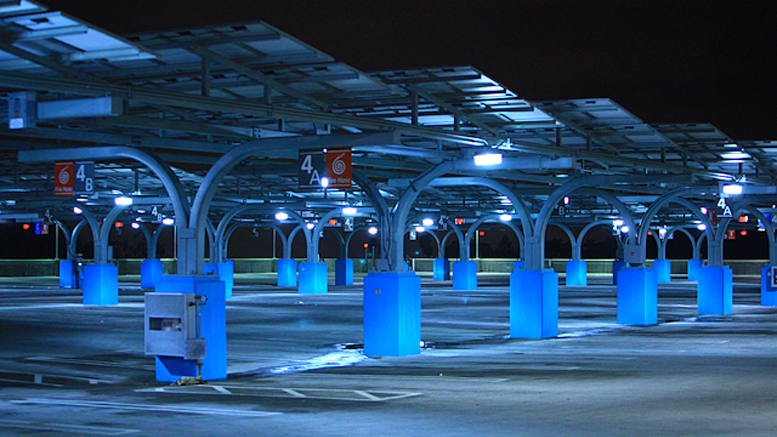Faced with declining public funds and less tuition revenue because of lagging enrollments, many community colleges are looking for ways to curb spending to balance their books. One area that several colleges have focused on is energy use, and some institutions have saved big bucks through energy-saving measures.
Mt. Hood Community College in Oregon, for example, trimmed $60,000 from its energy costs in 2016 by requiring staff to use scheduling software to heat and cool their rooms, said Charles George, director of facilities management. If they don’t, “the rooms are in standby mode,” meaning occupants could get uncomfortably hot or cold.
Because fewer classes are held in the summer, the college is looking into clustering them in the same location, so unused buildings or parts of buildings can be completely shut down.
Mr. Hood also reduced its $1.5 million annual electrical bill by $750,000 through a performance contract with Johnson Controls.
Between 2008 and 2012, the company replaced boilers and chillers, installed solar panels on roofs and a solar blanket on the swimming pool, put up LED lighting in parking lots and common areas, and upgraded other equipment. Because the college didn’t have the funds to do the work upfront, Johnson Controls provided financing and earns revenue from the savings.
As one way “to build energy conservation into the culture,” George said, a month-long competition pitted two departments against one another to see which would use less electricity. When the business office beat the student admissions area, it got a trophy and pizza party.
Last fall, Mt. Hood won first-place in the Campus Eco Challenge hosted by the Northwest Earth Institute. The goal, George says, is to engage employees in saving energy and adopting sustainable practices at home as well as at work, such as installing flow restrictors in showers and buying organic food. To celebrate its win, Mt. Hood is planning to host a conservation fair in the fall with educational seminars.
Lights out
Several energy efficiencies undertaken at the Brighton Campus at Monroe Community College in New York cut the college’s energy bills by more than 23 percent between 2011 and 2016, reports energy manager Travis Sleight.
One of the biggest changes involved transitioning from fluorescent to LED lighting. Occupancy sensors were installed in classrooms and hallways to automatically turn of the lights when no one is present.
Variable frequency drives on motors that run fans, and pumps allow the motors to slow down when demand is reduced, Sleight says.

A solar dining table at Mt. Hood Community College. (Photo: MHCC)
Demand-control ventilation systems were added to restrict the amount of fresh air pumped into large spaces – such as gymnasiums and auditoriums – when they’re not used. Also, building automation systems that control air-handling units are scheduled so buildings are not fully heated or cooled on nights and weekends.
A centralized co-generation plant on the Brighton Campus uses natural gas to generate electricity and heat at the same time. It runs parallel with the grid and can be adjusted to take advantage of market conditions. The college generates its own electricity and imports electricity to the grid. It adjusts the amounts based on how much heat the college wants to capture.
A huge solar array
As part of a huge construction project started in 2001 – that stresses sustainability and LEED certification – the Los Angeles Community College District (LACCD) has installed nearly 10 megawatts of solar energy across the district. The project resulted in cost avoidance of about $7 million, says utility program manager Aris Hovasapian.
Large solar arrays were placed over carports at seven of LACCD’s nine colleges. The district has avoided putting solar systems on the roofs of existing buildings as the extra weight raises seismic concerns.
“People here were looking at progressive solutions early on,” Hovasapian says. Several years ago, most colleges converted to a central utility plant that provides chilled and hot water to all buildings, rather than having individual units at each building.
LACCD is in its fourth year of an energy efficiency and job creation program funded by the California Clean Energy Jobs Act (Proposition 39). The district receives about $3 million to $4 million a year from the state, which helped to upgrade HVAC systems and convert exterior lighting to longer-lasting LED lights.
Among current efforts at LACCD, a stakeholder process, run by another company, aims to change employee behavior. Electric sub-meters installed at more than 150 buildings track use at the building level. Facility directors at each college use scheduling software to make the best use of buildings.
“We’re trying to schedule classes in a way that makes sense from an operations standpoint. We don’t want to open a class in an empty building,” Hovasapian. That’s a challenge, as each college has a lot of autonomy over operations and academics, and scheduling is done by the academics side.
Each college pays for its own utilities. If they save money by reducing energy costs, they’ll have more funds for other things, he says, noting that some colleges prioritize energy efficiency more than others.
LACCD also engages with community college energy and sustainability managers throughout the state to share best practices and discuss challenges.
For its next project, LACCD is considering the use of large commercial batteries to store solar energy, Hovasapian says. That could help the district meet a state mandate that half of produced energy must come from renewable sources by 2030.
Battery technology would allow the district to buy electricity from the grid when it’s cheapest and discharge it during peak usage times. It could also increase the amount of solar energy that could be sold back to the grid.
Behavior modification
Northwest Florida State College (NFSC) saved $2.04 million in energy costs over the past two years by making a few low-cost changes, but mostly by changing people’s behavior, said Randy White, vice president of administrative services.
The college is beginning the third year of a five-year contract with Cenergistic, an energy conservation consulting company that focuses on human behavior. NWFS pays the company $220,000 a year.
“This entrepreneurial approach to energy savings comes as the result of effective collaboration, planning, adoption and follow-through. Even in challenging times, we have realized significant savings,” says NFSC President Devin Stephenson. “There is no doubt our partnership with Cenergistic is a best practice model.”

Energy-efficient lights are installed at Metropolitan Community College. (Photo: MCC)
The college previously tried to get staff to cut energy use. But “we couldn’t do it on our own. We didn’t have enough knowledge to really convince people,” White says.
Cenergistic brought an engineer on campus to show people – with statistics – exactly how much money the college could save through certain behavioral changes. Staff are constantly reminded to turn off the lights at night and unplug office refrigerators during the weekend. Major systems are shut down on holidays and weekends.
Among the conservation measures implemented at the recommendation of Cenergistic: Motion sensors to automatically turned off lights in empty rooms, and centrally controlled thermostats so individuals can’t change the temperature. Buildings are cooled to 77 degrees in the summer and heated to 68 degrees in the winter.
A utility partnership
Metropolitan Community College (MCC) in Missouri greatly reduced its energy costs through a 20-year partnership with Kansas City Power & Light. The agreement guarantees the college savings of $20,000 a year, said Shelley Temple Kneuvean, vice chancellor for financial and administrative services.
In 2015, MCC installed solar arrays at 17 buildings on three campuses. Any leftover energy goes back to the grid.
The college had no out-of-pocket costs for the solar installation, Kneuvean says. The power company received rebates from the federal government, which it passed along to the college. MCC’s maintenance costs for the solar system are more than offset by the savings.
The college saved another $3 million by installing electronic ballasts in its indoor lighting systems to accommodate lower-energy light bulbs. That project covers two million square feet on all five campuses, Kneuvean says.
MCC is in the process of updating 600 exterior lighting fixtures – for parking lots and sidewalks – with high-efficiency LED lights. The college received a $400,000 loan from the Division of Energy at the Missouri Department of Economic Development for that project, which it plans to repay within five years.
The new lighting will not only cut energy costs – savings are guaranteed to be $75,000 a year – but will be brighter, thus increasing safety and security, Kneuvean says.
In addition, MCC is part of a strategic energy management partnership with Kansas University Medical School, the University of Kansas City, and Kansas City Power & Light involving an automated HVAC system allowing building superintendents to control temperatures remotely by phone. The electrical company is monitoring energy use, tracking peak times and using analytics to compare the partners’ energy use with total energy use on the grid.
There is no cost to MCC, Kneuvean says, because the federal government requires utility companies to improve energy efficiency and because the college already had a strong partnership with the electrical company. Construction is underway in a couple of buildings, and she expects to see a 5 percent to 20 percent reduction in electric bills.
“Making the time to do this work is very difficult because colleges are stretched, and the results aren’t seen right away,” Kneuvean says. “But it’s well worth it in the long term.”

